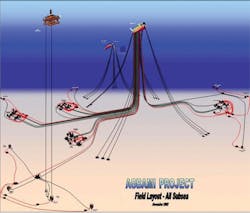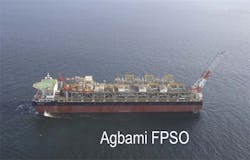Oil Fields Yield Digital Data
By Jim Montague, Executive Editor
There doesn’t appear to be lots of binary code floating on the high seas—until you look below the surface. For instance, Mark Lochmann, director of reservoir and production technology at Landmark Software and Services, a division of Halliburton (www.halliburton.com), reports that his company is using integrated production operations (IPO) software to help Chevron Corp. (www.chevron.com) coordinate numerous data sources at its Agbami field off the coast of Nigeria.
Better Data = Less Uncertainty
"Because oil and gas reserves are more complex, hard to reach and difficult to evaluate than ever, we're processing huge amounts of geologic, seismic and other raw data," said Lochmann. "And, while technology is key to reducing these uncertainties and improving efficiency, we're also seeing the need for an unprecedented convergence of people, processes and technology. As a result, all the oil companies have been developing ‘digital oil fields' by taking the practices they've learned over many years and using them to turn oil fields into factories with instruments and automation."
To aid these efforts, Lochmann added that Landmark has deployed 75 different software-based workflow projects over the past few years in offshore applications. One of the most instructive of these is the Agbami field, which is offshore about 200 kilometers southwest of Port Harcourt, Nigeria. The 2.5-year-old field's main reservoir is about 3050 meters deep, includes about 30 fuel, gas and water-injection wells in about 1500 meters of water, and produces about 250,000 barrels of oil per day that's worth about $20 million (Figure 1).
Because most of the field's operating assets are located beneath the ocean, Chevron uses a huge floating, production, storage and offloading (FPSO) vessel to help extract and transport the oil (Figure 2). The more than $1-billion FPSO has more than a dozen topside processing units, three gas compressors, and can store more than 2 million barrels of crude oil. It also can inject 450,000 barrels of water and 415 million cubic feet of gas per day into the field to help extract the oil, as well as process 450 million cubic feet of recovered gas.
Figure 2: The Agbami project's floating, production, storage and offloading (FPSO) vessel has more than a dozen topside processing units, three gas compressors, and can store more than 2 million barrels of crude oil.
Coordinating Efforts
The field and the FPSO's safety instrumented system (SIS), process shutdown (PSD) and power management distribution systems come from Rockwell Automation's (www.rockwellautomation.com) ICS Triplex division, and include approximately 6000 I/O points going to multiple trusted triple modular redundancy (TMR) systems. These systems were built in Singapore, delivered to the FPSO's module shipyard in Korea and are now engineered, programmed and managed from Houston. In addition, the FPSO and the field's power management distribution system exchanges 50,000 tags with the FPSO's distributed control system (DCS). Coordinating all this data isn't easy.
"Agbami's first iField objective is to capture and manage sub-surface, subsea, topside, real-time and historical data," explained Lochmann. "Its second aim is to facilitate asset management work processes by accurately characterizing the reservoir; optimizing the displacement efficiency, water and gas injection performance; improving ultimate recovery; and then feeding into well-work and base-business operations. Because all the assets are subsea, Chevron has to know what's going on down there."
To help Chevron meet its goals for the field, Lochmann reports that Landmark implemented and Abgami is now running 35 workflow processes of its DecisionSpace for Production architecture and infrastructure. However, because these workflows include 16,000 applications and 10,000 to 12,000 databases in the exploration and production space, Landmark also employs Rockwell's VantagePoint oftware to help coordinate all these data sources and get them to present their information in a more uniform way. These data sources comes from a variety of software vendors, including Landmark, AspenTech, TietoEnator, Schlumberger, Microsoft, Oracle, Honeywell, Yokogawa, OSisoft, GE Intelligent Platforms, Matrikon, IBM, SAP, Rockwell and others.
Lochman adds that coordinating and standardizing all these data sources with VantagePoint produced some startling benefits for the Agbami field and its FPSO. "It's achieved about a 95% uptime for well availability and facilities, compared to 50% to 65% initially projected, and is projected to save about $10 million per year in otherwise lost production," says Lochmann. "Most interestingly, we've also seen a 98% reduction in non-productive time associated with data access and management procedures.
Jim Montague is Control's executive editor.



